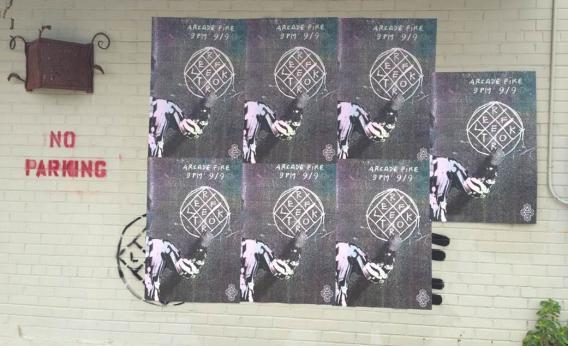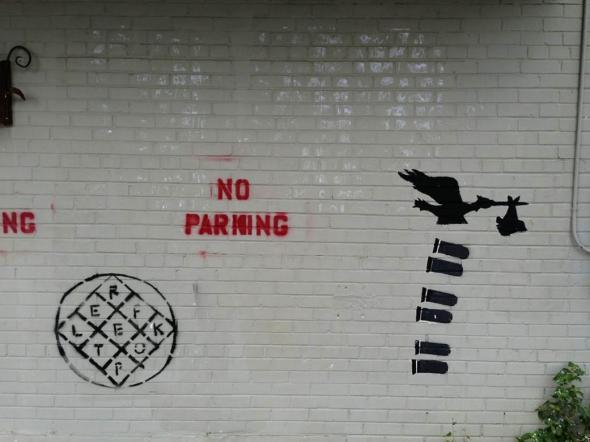A few weeks ago, my wife noticed a logo spray-painted on the long gray wall of the custom picture framing shop where she works in Austin, Texas’s gallery district. Along the wall, there is already a large, colorful mural, a few “no parking” stencils, and some street art of a stork dropping bombs from its satchel. (I’d call the stork graffiti, but it’s beloved by my wife and me, and the shop’s owner. Thus: art.)
At the time, my wife and I had no idea what the logo represented. It was round with crosshatched lines and some letters, but we couldn’t make out what they said. It was weird. Not as cool as the stork. But at least it wasn’t a tag, we decided.
Then, early in the morning on Monday, when no one was watching, a plethora of posters for Arcade Fire’s eagerly anticipated single and forthcoming double album, Reflektor, were plastered up on the wall. The posters bore the same logo as the stencil they now covered up. Suddenly we got it. And we weren’t all that stoked that Arcade Fire had blessed us with its marketing.

Ian Dille
The graffiti has popped up around the world, in London, Berlin, Sydney—and throughout Austin, on the walls of sandwich shops and taco stands, on the sidewalks downtown, and even on our much-cherished Pfluger pedestrian bridge, which spans Lady Bird Lake and provides a stunning view of the sun setting over the hills. The band has unfurled a banner bearing the graffitied logo in New York, along with the numbers 9/9/9, the date and time the single dropped, and the same day my wife’s wall got plastered. Bandleader Win Butler has called all of this a “weird art project.”
Now, my wife and I are fans of Arcade Fire. I’ve listened to them since college, when they were a little indie act out of Canada, not the multimillion-dollar Grammy-winning band they are today. I take some strange pride in the fact that Butler grew up in Texas, too. But unlike a lot of people, who thought the graffiti campaign was ingenious, when I found out the logo was nothing but a commercial promotion I felt … used. Even—and maybe this is too harsh?—a little betrayed.
I’m not just saying that because my wife’s boss spent hours cleaning the posters and paste off the wall. As Arcade Fire has achieved mainstream success, they’ve also struggled to maintain their indie appeal. How does a band preserve its counter-culture ethos when it’s on stage with industry stars accepting a Grammy for best album? Many bands have struggled with this problem, and Arcade Fire has generally handled it fairly well. The band’s lyrics have grown more mature over time, broaching social issues like urban sprawl (on The Suburbs) and social media’s tendency to disengage us from reality (in the lyrics of “Reflektor”). But the band’s vandalism—er, “guerrilla marketing”—seems, in contrast, decidedly immature, or at the very least socially irresponsible.
If you’re a talented young artist who considers the urban environment your canvas, by all means, spray-paint a building. If you’ve got a radical social agenda and you think spray-painting property is the best way to convey your message? Go ahead. If you’re a gangbanger and you want to mark your territory, I can learn to live with that.
But if you’re an internationally renowned band that’s defacing public and private property for promotional purposes, maybe go back to the drawing board, and think some more about how you want to let people know about your music.
Update, 2:38 p.m.: The head of a PR company working with Arcade Fire sent me a handwritten note from Win Butler and said I was free to publish it if I wished. It’s below.
